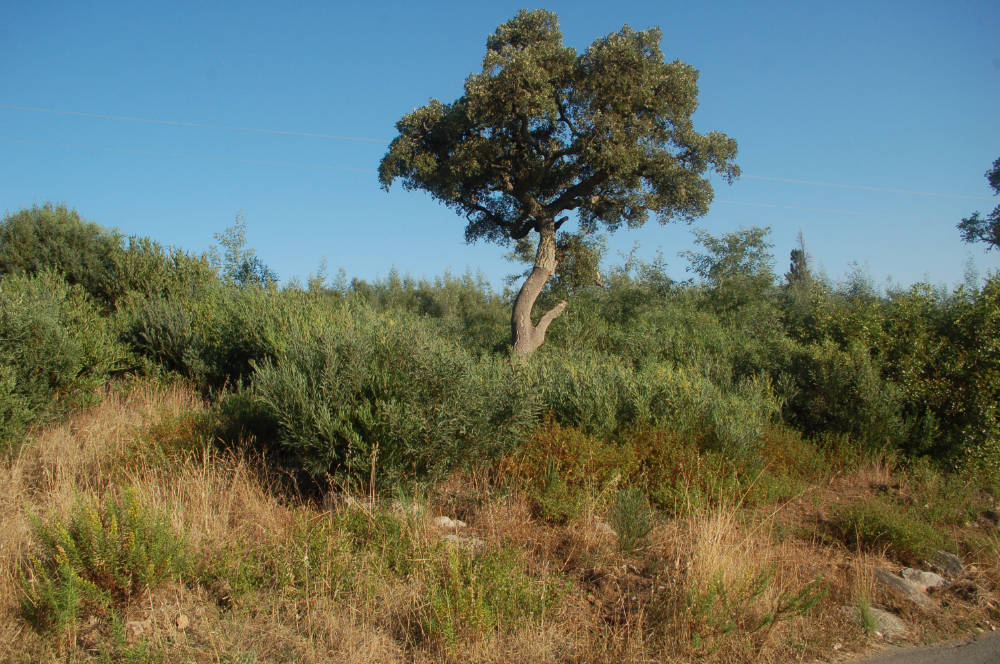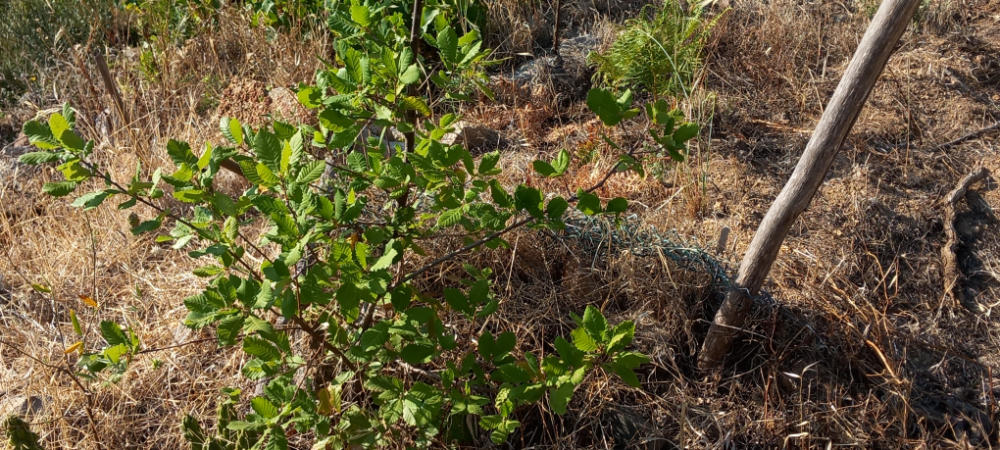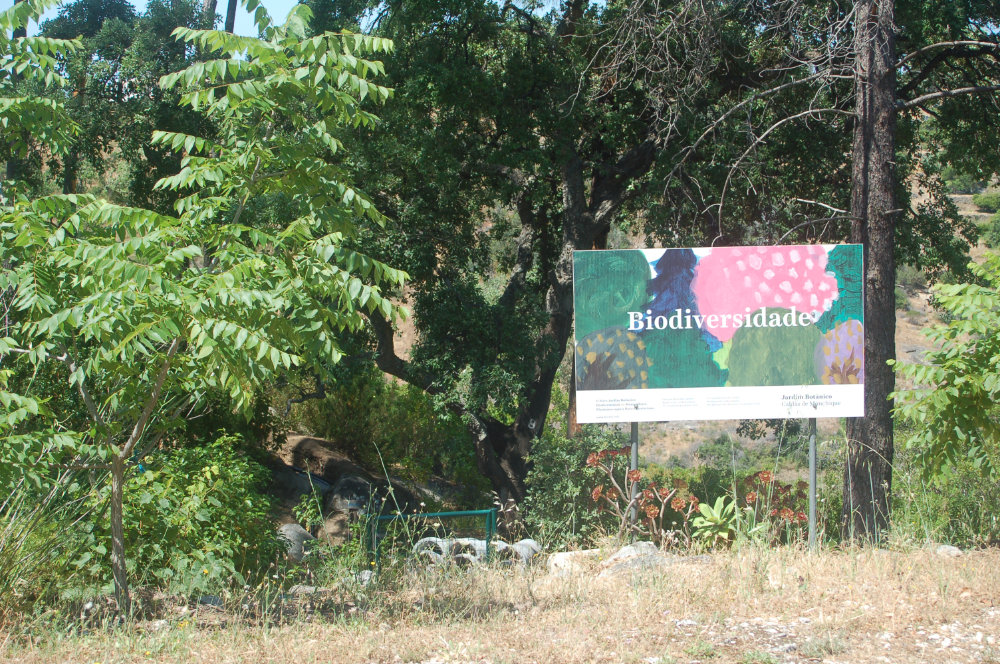Saturday 1st July 2023.
This story begins with the loss of woodlands. The error that is committed (not only) in Monchique is probably that the forest, ie nature, is always only viewed as a commercial space. This means that any investment in forests has to yield a profit, for otherwise this investment is not worth our while. Now this refers not only to financial interests but also to labour, the physical investment, involving hours, days and weeks. So is the forest nothing but a commercial surface, something like a sausage factory? Doesn‘t the forest also hold something fundamentally honourable: conservation, natural heritage, beauty? Why don’t we look at the woods in that perspective.
For many years now I’ve been thinking about what my work as a journalist has in common with planting trees? Are there points where they overlap? A newspaper is printed on paper – for which, over hundreds of years, trees have been felled and their wood transformed into paper. This brought forth a business idea, which in turn spawned monoculture. This was how the forestry business was born, with trees planted in rows…
I remember once helping a friend to pick berries that he used to make medronho firewater. Now I helped the same friend to unload a truckful of bales of straw that he needed for his cows, to get them through the dry hot summer. I never wanted payment for this. And after the great forest fire of 2003, our readers helped me plant some 5,000 trees in the winter of 2004. That was voluntary work. It was also the first time I was asked what I was earning with that. At the time I didn’t understand right away what the question was referring to, as my profession is journalism, and I’m not from Monchique originally. I’m paid by „written word“ and „published photograph“. Guilelessly I replied that I planted trees because I enjoyed it. This was met with a laugh. Not a clean laugh I should say. It was a dirty laugh, as I quickly realised that my reply made me out to be stupid. So if you do something for pleasure you’re not quite right in the head. Well, just maybe I’m not quite normal.
After each forest fire I started the task of compensating the loss of forest by planting new native trees. In doing so I noticed that in Monchique, reforesting is not an issue that is being discussed. Forest, you see, is „business“. You could see burnt cork oaks simply being replaced by eucalyptus. And every forest fire left behind gaps at first, then fallow ground, and at some stage bare rock, as the soil was gone with the wind, and there were no longer any tree roots available to retain the water and fix the soil. And then we saw the arrival of the invasive plants. Imagine the felling of an invasive tree, a plant brought to Portugal in the mid-19th century from Australia: an acacia or a mimosa. Now a lime or a pine tree, or any other native tree would be gone after a forest fire or after being felled – the acacias and mimosas however spring to life after being chopped down. All of a sudden ten new trees appear, and from those ten more new acacias and mimosa in the shortest time, and so on and so forth. Their roots grow far across as well as deep down, and they develop their communications system within the soil. This tree species is far superior to humans. To this day, most local tree loggers have not understood the invasive trees’ way of life. They think that using a brushcutter solves the problem. However, those felling an acacia with a brushcutter have to be prepared to see ten or more acacias growing on their plot of land the following year. And the multiplication is not linear …
If we were to hold a native tree, and with that the forest, to be something valuable, as something of priceless value, unique, not convertible into money, but as a kind of life insurance, we’d quickly enter into a relationship with the forest, a friendship for life, then we’d rapidly recognise that it is giving us the air we breathe, transforming the CO2 we humans give it into oxygen that the tree gives us in exchange. Trees provide us with shade, they give us fruits, a sense of direction. Life is an eternal give and take. Which is why I see a deeper meaning in planting a new forest in exchange for my printed paper: the new Botanical Gardens of Caldas de Monchique. At some point this is intended to be what Monchique used to be for many centuries, the green lung of the Algarve, at least a small part of it, a reminder of those better days. And it’s not so long ago that fathers used to plant trees for their children, or grandparents for their grandchildren. It was an investment in the future.
Planting a diverse forest at the start of climate change? That’s exactly what it is. Not so easy when water is getting ever more scarce. So: catch every drop of rain and conserve it. Use rainwater to water young trees. Use rainwater to install a protection system guarding against forest fires: sprinklers. Plant many native trees that have no commercial value but a high symbolic value instead: the Monchique oak for instance (Quercus canariensis). This is one of the most beautiful trees actually: a tree that needs very little water, and when it does grow up to be taller, becomes a strong friend, made of a hardwood that insects struggle to burrow into. The goal of the new Botanical Gardens of Caldas de Monchique is to preserve many different kinds of old trees, including the elm (Ulmaceae), which has been at home in our village for centuries. But also the umbrella pine, the casuarina, the carob, walnut and almond tree, the alder and the ash, and many more. This story ends with gaining forests. This is the only natural response to climate change. Plant trees, for enjoyment – and protect your friends from forest fires! Be careful and don’t play with fire!
 Eco123 Revista da Economia e Ecologia
Eco123 Revista da Economia e Ecologia







